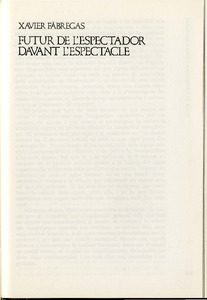Mostrar el registro sencillo del ítem
Futur de l’espectador davant l’espectacle
| dc.contributor.author | Fàbregas, Xavier | |
| dc.date.accessioned | 2022-12-30T16:29:29Z | |
| dc.date.available | 2022-12-30T16:29:29Z | |
| dc.date.issued | 1983 | |
| dc.identifier.issn | 2385-362X | |
| dc.identifier.issn | 0212-3819 | |
| dc.identifier.uri | http://hdl.handle.net/20.500.11904/1373 | |
| dc.description.abstract | <p>Cinema, drama and television are languages composed of some groups of signs, and we will only be able to know the specific character of each entertainment if before we can define them separately. Between drama and cinema, we must place another kind of entertainment which acts as a link from the semiotic point of view, the shades: Performance/Reproduction and Actor - Object/Image of Actor or Object become the factors to combine. Starting from here, we can set up seven binary constructions which will enable us to judge the relation of the audience with every kind. of entertainment. Although we accept the relative value of the data, it is possible to get a graph from the participation's values of the audience in every considered entertainment: television shows an inflexion of the graphic line towards the return to an immediacy of the audience in front of the entertainment (being that of the cinema the farthest point on the graph) but in exchange it destroys the audience in its capacity as member of a social class.</p> | |
| dc.relation.ispartof | Estudis escènics: quaderns de l'Institut del Teatre. 1983, Núm. 23 | |
| dc.title | Futur de l’espectador davant l’espectacle | |
| dc.type | Article | |
| dc.date.updated | 2022-12-30T16:29:30Z | |
| dc.rights.access | Open Access |
Ficheros en el ítem
Este ítem aparece en la(s) siguiente(s) colección(ones)
-
1983: Núm.: 23 [7]


